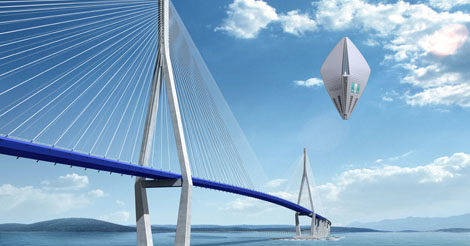Aircruise Design Innovation Muse | 3D PERSPECTIVES

When I watched the Aircruise concept video, I got all musical. Van Morrison’s “Moondance” came to mind, as well as “Up Up and Away”
You see Aircruise is not a hot air balloon, nor a cruise ship, nor hotel. It’s kind of a combination of all. An air-floating vessel for folks who like the luxury of slow.
 Hoping it’ll get you musical as well, I’d like to show you the video and then share my interview with Nick Talbot, design director at Seymourpowell (the design and innovation company behind Aircruise).
Hoping it’ll get you musical as well, I’d like to show you the video and then share my interview with Nick Talbot, design director at Seymourpowell (the design and innovation company behind Aircruise).
Here’s what I asked Nick:
Interview with Nick Talbot:
Q: I’ve read that Aircruise is a “visionary approach to the future.” Your design certainly inspires, but how feasible would it be to build today given existing materials? What must we invent to permit the production of Aircruise?
Many of the materials required are already in use on airliners and increasingly on luxury yachts to minimise weight . For example carbon composites or carbon/carbon honeycomb, or aluminium honeycombs faced with the appropriate aesthetic finish. We are also interested in exploring new forms of woven and ‘constructed’ fabrics for partitions and facades – again in pursuit of minimum weight. For the primary structure, we foresee an all composite lattice, with the gas systems integrated into the structural frame. Our underlying idea is to apply aerospace materials and assembly technologies and techniques to a vehicle at the scale of the Tour Eiffel. Probably assembled top down or hung like a ‘seed’ so the primary structure is in tension before the lifting bags are introduced.
Q: Aircruise is designed to be powered by natural energy. How would this work?
Flexible photovoltaic (solar panel) cells cover the upper part of the envelope, augmenting the primary power generation, in this case from fuel cells. Large surface area PEM fuel cells generate the primary power for on board systems and turn low speed compressors located in the mid section of the ship. This compressed gas is ducted to provide directional thrust and auto stabilisation. Compressed hydrogen stored in parts of the main structure provides fuel for longer ranges and by venting to the envelope or re-compressing these volumes, altitude stability is achieved.
Q: How important was 3D software to your design concept, and at what stage did you integrate it to your process?
Generating the concept or indeed any concept is still done with brains and pencils! So the conceptual jump to a luxury hotel that floats was a thought exercise. Very rapidly however, we developed a series of layouts and configurations for the structure, accommodation floors, systems and overall volume of the lifting volume. So 3D systems rapidly help us validate early weight and lifting volume calculations, even at the most basic level.
Q: What is the relationship between 3D, creative ideation and innovation?
For our studio the relationship is very close and entirely iterative. We establish an idea or ‘hypothesis’ and use 3D systems to validate at the first round, then re-evaluate the outcome, generate refined or modified ideas and take them back into 3D. We never commit time and resource to 3D models until we have a clear idea of the concept, however. The idea must be conceptually robust before we take it to the 3D phase. In fact, ‘old fashioned’ as it sounds we still often use simple 2D systems to establish the basic proportions and layouts before importing that for surface and volume building.
Q: When can I spend the night in the Aircruise?
Watch this space! It is possible – in a sense that’s key the point of the project, to encourage people to think about a positive brighter future, to think about new possibilities. But of course such a project would require huge investment in R+D, new materials, structures, guidance and control systems etc. It is unlikely that an individual company or consortium could afford this undertaking on a commercial basis at present. But who knows – as land values increase or the sea levels rise, we might have to look at how and where we live in a whole new way. What’s really needed is some seed funding to undertake a proper feasibility study –not just from an engineering viewpoint, but potential market and business case. Never say never!
Many thanks Nick for your answers and to Tim Duncan for putting us in touch!
I’d certainly like to fly in [your] beautiful balloon hotel!
What do you readers think about Aircruise?
